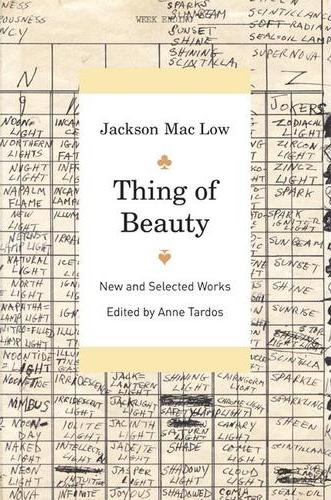Thing of Beauty truly is. The first real attempt at a comprehensive selected poems by Jackson Mac Low since the 1986 publication of Representative Works 1938 – 1985, half of this new volume, impeccably edited by Mac Low’s longtime partner & collaborator Anne Tardos, was written after the completion of that earlier book. Thus the subtitle New and Selected Works.
Thing of Beauty carefully lays out the scope of a great career that lasted just shy of seventy years. Indeed, Mac Low had just turned fifteen when he composed the volume’s title poem. It’s a lyric such one might expect of a boy. Yet already we see the impulse toward systematic changes that will lead Mac Low to become the great champion of chance and anti-ego-centered techniques in American poetry as well as the anti-war commitment that he carried without hesitation throughout his life:
It was a thing
of Beauty;
Small, precious
Not strong nor large,
But beautiful.
She was a thing
Of Beauty;
Slender, graceful
Not strong nor tall,
But beautiful
He was a thing
Of Beauty;
Tall, manly
Not small nor delicate
Like the other
Beautiful things,
But beautiful.
Came War
Came Slaughter
And Destruction;
Wrought for holy causes –
They said.
Both sides fought
For the Good
Of Mankind
By destroying
The things
Of Beauty
The Small and Precious
The Slender and Graceful,
The Tall and Manly;
Destroyed,
Transformed by men;
It, to a meaningless
Powder
She, to a shapeless,
Jellylike Mass
Of Matter
He, to a festering
Limbless,
Decapitated,
Corpse.
The good of Mankind
Was served –
They said.
This poem actually occurs earlier than any in Representative Works. That volume starts with what is the second poem here – Mac Low has just turned sixteen and already is using typography in ways that other poets would not catch up with for forty years: HUNGER STrikE wh At doe S lifemean is the title.
It’s that lag process, being so far out in front of everyone else, that gave rise to Mac Low’s reputation in the early 1960s as a “slow starter.” By the time he was 48 years old – 1970 – he’d published just four books. One of these, fortunately, was 22 Light Poems from Black Sparrow. That collection must have been a strategic act on Mac Low’s part – and very probably on the part of publisher John Martin as well – since Mac Low’s process in the Light Poems of writing poems employing randomly chosen modes of light (from a list of “280 kinds of light, plus eight ‘extras’” deployed using playing cards plus the RAND Corporation’s A Million Random Digits with 100,000 Normal Deviates) yielded texts that were sweet & quirky, but entirely readable by anyone with no familiarity whatsoever with these kinds of ultra-avant shenanigans. Three years later, Dick Higgins published what at the time seemed to be Mac Low’s magnum opus, Stanzas for Iris Lezak.¹ Between the two books, Mac Low had become both famous & widely read, if not yet widely understood. Twelve years later, tho, Mac Low’s sixtieth birthday was celebrated with a festival in
Thing of Beauty differs from Representative Works in some important ways beyond its generous representation of material from the last two decades of Mac Low’s life. Its selection from the early years, literally 48 years of writing, is necessarily 100 pages shorter than the earlier book. But even more important, Tardos has done a much better job than Mac Low himself in organizing these materials to create a coherent path through one of the largest & most ambitious oeuvres ever. Perhaps
Tardos’ organization makes this a perfect “first book” for anyone who may be interested in starting to explore Mac Low’s work. My own sense is that you will quickly want to turn from these brief selections – there are just ten Light Poems (of which no “complete” edition has ever appeared in print), just seven of the 100 poems that compose The Twenties, just forty pages to represent the 424 of Stanzas for Iris Lezak, etc. – and start a collection of everything you can get your hands on.
Perhaps the most telling absences here are those that would more properly have appeared on a CD & a DVD, documentation of Mac Low’s performances, the intersection between poetry & contemporary post-classical music that is so important for Mac Low (He is alleged to have taught chance technique to John Cage & certainly Mac Low is a much more powerful user of these tools in the field of literature). Also, the crisp page design of UC Press, terrific for traditional text, even when composed in the least traditional of methods, doesn’t fully suit the holographic vispo manuscripts that Mac Low created for many of his performances. Granary Press’ Doings: Assorted Performance Pieces, 1955 – 2002 is an excellent choice for the person who has finished Thing of Beauty and then asks the inevitable question: Which book should I read next?
What we really need, ultimately, is the Complete Jackson Mac Low, a multi-volume multimedia project on the scale of the works, say, of Walter Benjamin or Charles Olson or Gertrude Stein. Thing of Beauty is a good first step in the direction of creating that broader picture, but it’s only the tip of a far more vast canon on the part of the most broadly brilliant innovator of – at the very least – the last half century.
¹ I once took a job at an alternative weekly newspaper in
² This is, I believe, the only time ever that all five contributors to the collaboration Legend – Bruce Andrews, Charles Bernstein, Steve McCaffery, Ray DiPalma & yours truly – were ever in the same room simultaneously.






